Belizean vs Inupiat Community Comparison
COMPARE
Belizean
Inupiat
Social Comparison
Social Comparison
Belizeans
Inupiat
1,156
SOCIAL INDEX
9.1/ 100
SOCIAL RATING
320th/ 347
SOCIAL RANK
2,695
SOCIAL INDEX
24.5/ 100
SOCIAL RATING
244th/ 347
SOCIAL RANK
Inupiat Integration in Belizean Communities
The statistical analysis conducted on geographies consisting of 60,241,549 people shows a moderate positive correlation between the proportion of Inupiat within Belizean communities in the United States with a correlation coefficient (R) of 0.457. On average, for every 1% (one percent) increase in Belizeans within a typical geography, there is an increase of 0.135% in Inupiat. To illustrate, in a geography comprising of 100,000 individuals, a rise of 1,000 Belizeans corresponds to an increase of 134.7 Inupiat.
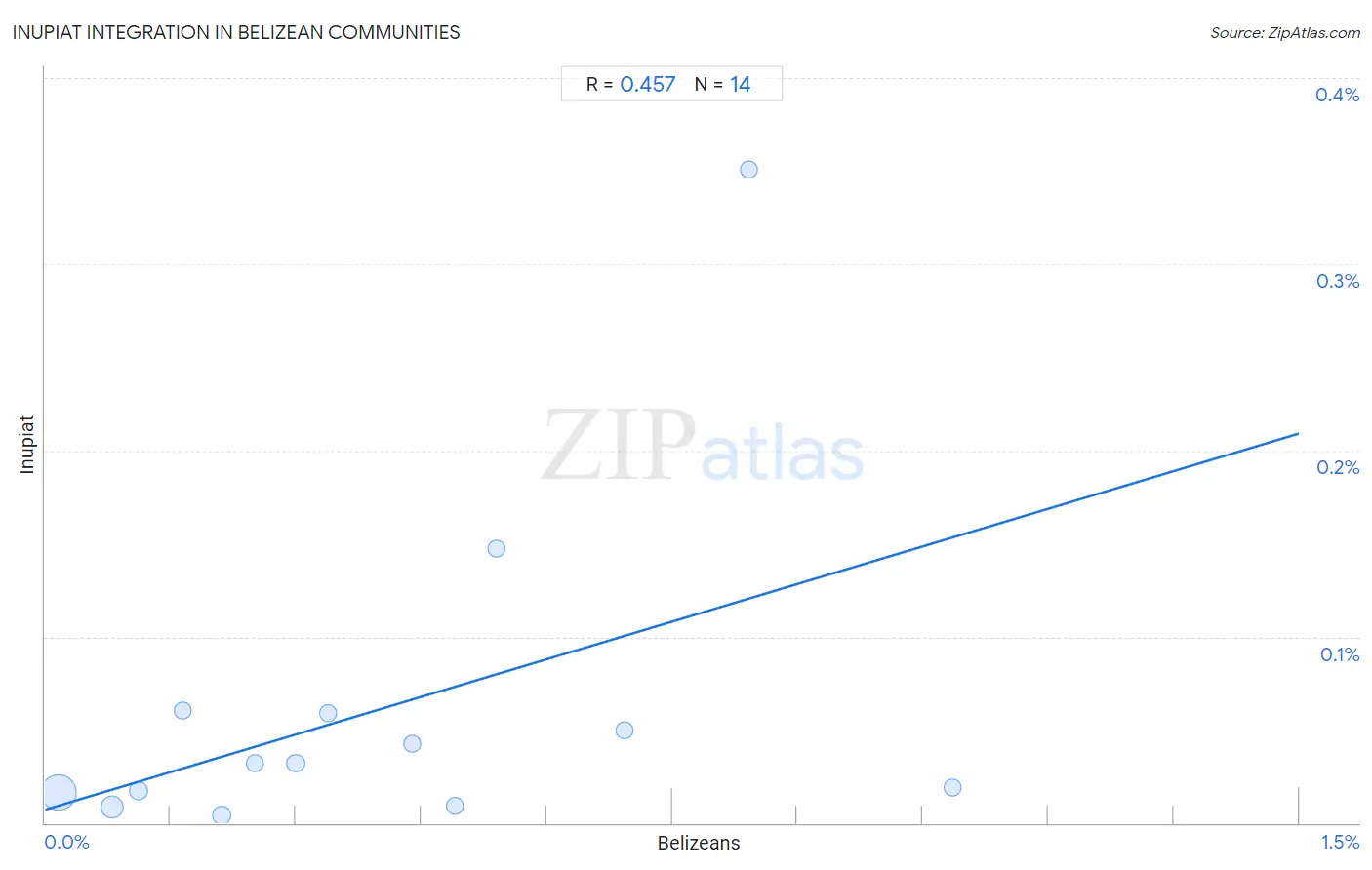
Belizean vs Inupiat Income
When considering income, the most significant differences between Belizean and Inupiat communities in the United States are seen in householder income over 65 years ($54,580 compared to $61,061, a difference of 11.9%), householder income under 25 years ($51,094 compared to $55,935, a difference of 9.5%), and median female earnings ($37,429 compared to $40,080, a difference of 7.1%). Conversely, both communities are more comparable in terms of householder income ages 25 - 44 years ($84,534 compared to $84,619, a difference of 0.10%), median earnings ($42,702 compared to $43,000, a difference of 0.70%), and median family income ($90,880 compared to $91,730, a difference of 0.94%).

| Income Metric | Belizean | Inupiat |
| Per Capita Income | Tragic $39,097 | Tragic $36,999 |
| Median Family Income | Tragic $90,880 | Tragic $91,730 |
| Median Household Income | Tragic $77,028 | Tragic $78,841 |
| Median Earnings | Tragic $42,702 | Tragic $43,000 |
| Median Male Earnings | Tragic $48,358 | Tragic $47,281 |
| Median Female Earnings | Tragic $37,429 | Good $40,080 |
| Householder Age | Under 25 years | Tragic $51,094 | Exceptional $55,935 |
| Householder Age | 25 - 44 years | Tragic $84,534 | Tragic $84,619 |
| Householder Age | 45 - 64 years | Tragic $88,684 | Tragic $91,355 |
| Householder Age | Over 65 years | Tragic $54,580 | Average $61,061 |
| Wage/Income Gap | Exceptional 21.2% | Exceptional 20.8% |
Belizean vs Inupiat Poverty
When considering poverty, the most significant differences between Belizean and Inupiat communities in the United States are seen in single male poverty (13.4% compared to 20.0%, a difference of 48.9%), receiving food stamps (14.8% compared to 20.1%, a difference of 35.2%), and female poverty among 25-34 year olds (15.1% compared to 18.5%, a difference of 23.1%). Conversely, both communities are more comparable in terms of poverty (14.8% compared to 15.1%, a difference of 1.7%), female poverty (15.9% compared to 16.2%, a difference of 1.9%), and male poverty (13.6% compared to 14.0%, a difference of 2.6%).
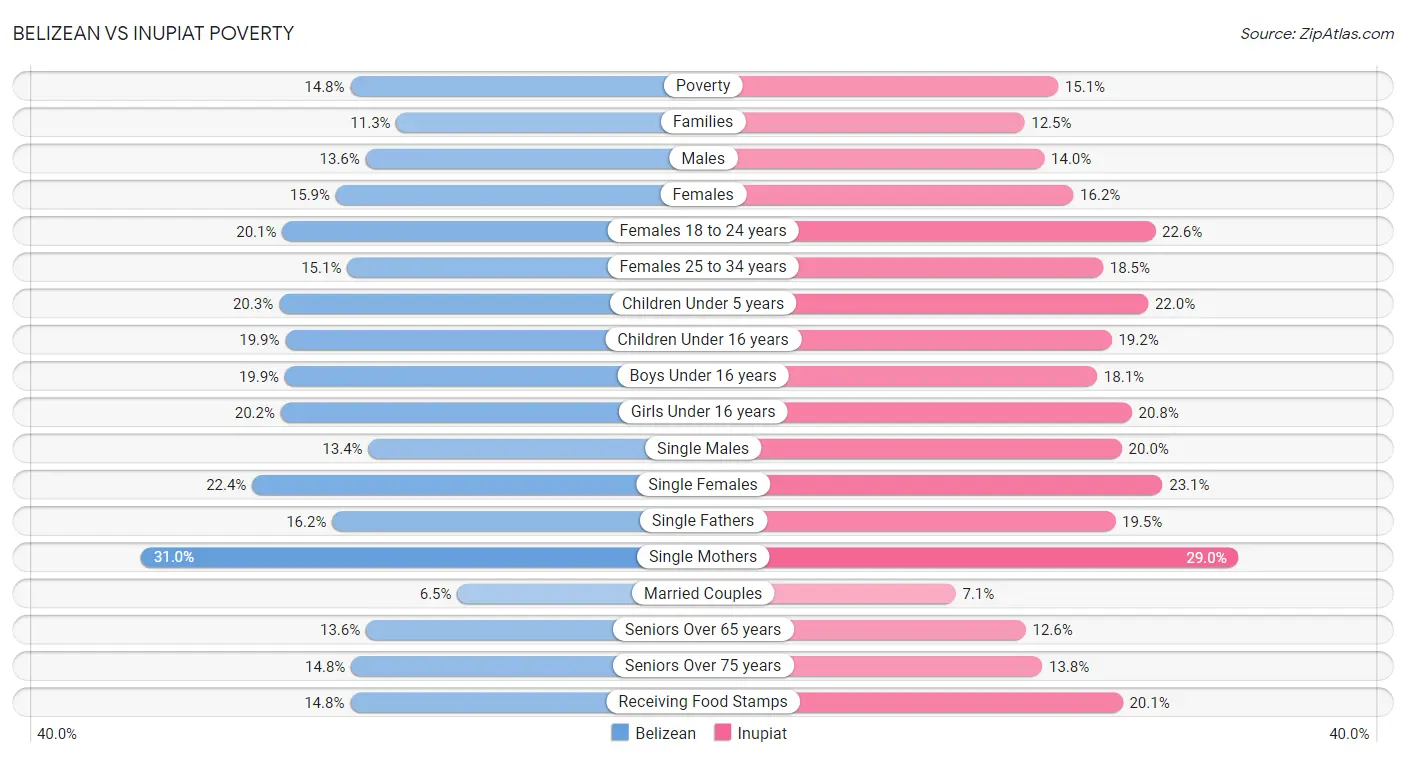
| Poverty Metric | Belizean | Inupiat |
| Poverty | Tragic 14.8% | Tragic 15.1% |
| Families | Tragic 11.3% | Tragic 12.5% |
| Males | Tragic 13.6% | Tragic 14.0% |
| Females | Tragic 15.9% | Tragic 16.2% |
| Females 18 to 24 years | Average 20.1% | Tragic 22.6% |
| Females 25 to 34 years | Tragic 15.1% | Tragic 18.5% |
| Children Under 5 years | Tragic 20.3% | Tragic 22.0% |
| Children Under 16 years | Tragic 19.9% | Tragic 19.2% |
| Boys Under 16 years | Tragic 19.9% | Tragic 18.1% |
| Girls Under 16 years | Tragic 20.2% | Tragic 20.8% |
| Single Males | Tragic 13.4% | Tragic 20.0% |
| Single Females | Tragic 22.4% | Tragic 23.1% |
| Single Fathers | Average 16.2% | Tragic 19.5% |
| Single Mothers | Tragic 31.0% | Good 29.0% |
| Married Couples | Tragic 6.5% | Tragic 7.1% |
| Seniors Over 65 years | Tragic 13.6% | Tragic 12.6% |
| Seniors Over 75 years | Tragic 14.8% | Tragic 13.8% |
| Receiving Food Stamps | Tragic 14.8% | Tragic 20.1% |
Belizean vs Inupiat Unemployment
When considering unemployment, the most significant differences between Belizean and Inupiat communities in the United States are seen in unemployment among women with children under 6 years (8.4% compared to 17.7%, a difference of 110.3%), male unemployment (6.5% compared to 12.1%, a difference of 85.8%), and unemployment among ages 20 to 24 years (11.8% compared to 20.9%, a difference of 77.2%). Conversely, both communities are more comparable in terms of unemployment among seniors over 65 years (5.5% compared to 5.8%, a difference of 5.3%), unemployment among seniors over 75 years (8.4% compared to 9.1%, a difference of 9.1%), and female unemployment (6.3% compared to 8.2%, a difference of 28.6%).
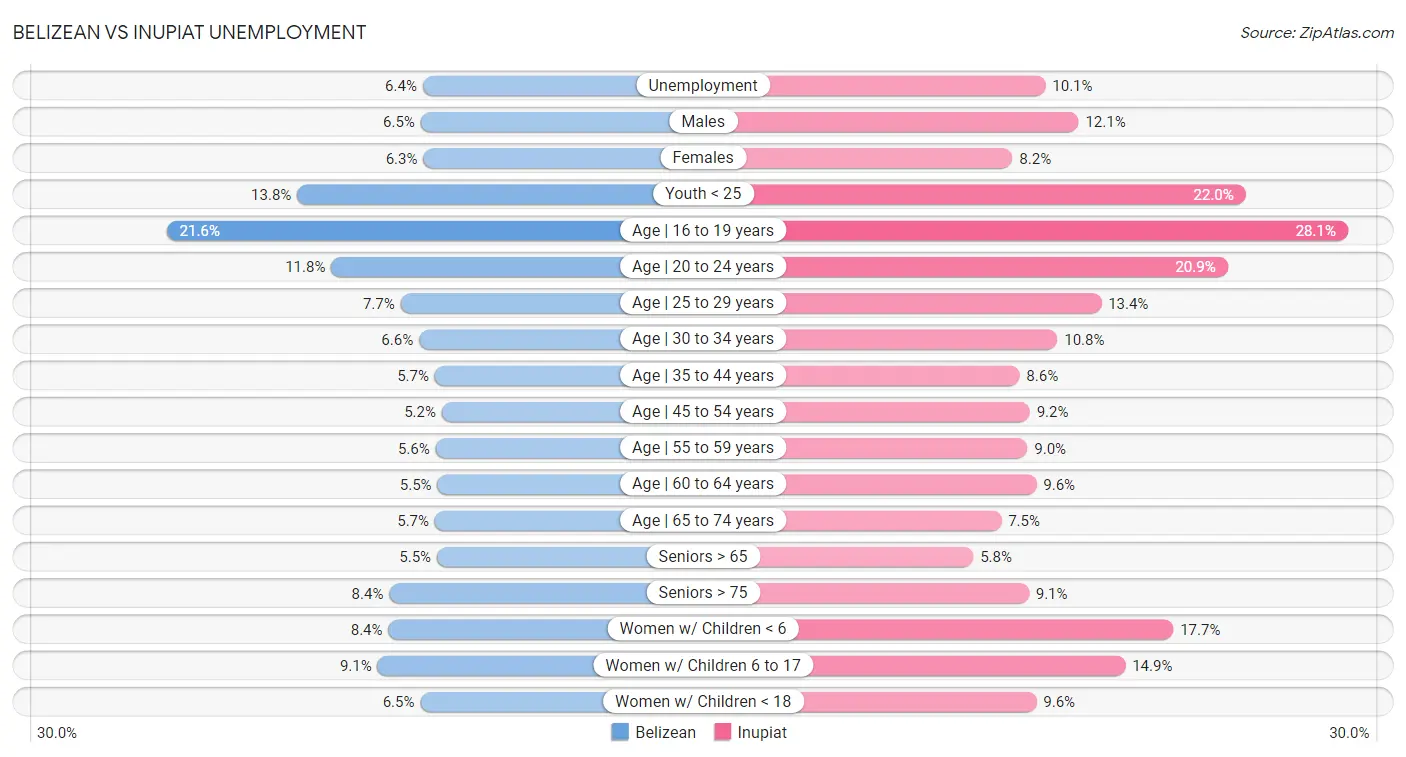
| Unemployment Metric | Belizean | Inupiat |
| Unemployment | Tragic 6.4% | Tragic 10.1% |
| Males | Tragic 6.5% | Tragic 12.1% |
| Females | Tragic 6.3% | Tragic 8.2% |
| Youth < 25 | Tragic 13.8% | Tragic 22.0% |
| Age | 16 to 19 years | Tragic 21.6% | Tragic 28.1% |
| Age | 20 to 24 years | Tragic 11.8% | Tragic 20.9% |
| Age | 25 to 29 years | Tragic 7.7% | Tragic 13.4% |
| Age | 30 to 34 years | Tragic 6.6% | Tragic 10.8% |
| Age | 35 to 44 years | Tragic 5.7% | Tragic 8.6% |
| Age | 45 to 54 years | Tragic 5.2% | Tragic 9.2% |
| Age | 55 to 59 years | Tragic 5.6% | Tragic 9.0% |
| Age | 60 to 64 years | Tragic 5.5% | Tragic 9.6% |
| Age | 65 to 74 years | Tragic 5.7% | Tragic 7.5% |
| Seniors > 65 | Tragic 5.5% | Tragic 5.8% |
| Seniors > 75 | Exceptional 8.4% | Tragic 9.1% |
| Women w/ Children < 6 | Tragic 8.4% | Tragic 17.7% |
| Women w/ Children 6 to 17 | Fair 9.1% | Tragic 14.9% |
| Women w/ Children < 18 | Tragic 6.5% | Tragic 9.6% |
Belizean vs Inupiat Labor Participation
When considering labor participation, the most significant differences between Belizean and Inupiat communities in the United States are seen in in labor force | age 16-19 (32.8% compared to 35.0%, a difference of 6.8%), in labor force | age 30-34 (83.5% compared to 79.7%, a difference of 4.7%), and in labor force | age 25-29 (83.1% compared to 79.8%, a difference of 4.2%). Conversely, both communities are more comparable in terms of in labor force | age > 16 (64.8% compared to 64.3%, a difference of 0.88%), in labor force | age 45-54 (80.8% compared to 79.9%, a difference of 1.1%), and in labor force | age 20-24 (73.4% compared to 74.6%, a difference of 1.7%).

| Labor Participation Metric | Belizean | Inupiat |
| In Labor Force | Age > 16 | Poor 64.8% | Tragic 64.3% |
| In Labor Force | Age 20-64 | Tragic 78.2% | Tragic 76.1% |
| In Labor Force | Age 16-19 | Tragic 32.8% | Tragic 35.0% |
| In Labor Force | Age 20-24 | Tragic 73.4% | Poor 74.6% |
| In Labor Force | Age 25-29 | Tragic 83.1% | Tragic 79.8% |
| In Labor Force | Age 30-34 | Tragic 83.5% | Tragic 79.7% |
| In Labor Force | Age 35-44 | Tragic 83.1% | Tragic 80.9% |
| In Labor Force | Age 45-54 | Tragic 80.8% | Tragic 79.9% |
Belizean vs Inupiat Family Structure
When considering family structure, the most significant differences between Belizean and Inupiat communities in the United States are seen in single father households (2.6% compared to 4.9%, a difference of 86.8%), births to unmarried women (37.0% compared to 52.1%, a difference of 40.7%), and family households with children (27.8% compared to 32.8%, a difference of 18.2%). Conversely, both communities are more comparable in terms of married-couple households (42.2% compared to 42.4%, a difference of 0.39%), currently married (42.2% compared to 41.3%, a difference of 2.1%), and family households (64.8% compared to 67.8%, a difference of 4.7%).

| Family Structure Metric | Belizean | Inupiat |
| Family Households | Excellent 64.8% | Exceptional 67.8% |
| Family Households with Children | Exceptional 27.8% | Exceptional 32.8% |
| Married-couple Households | Tragic 42.2% | Tragic 42.4% |
| Average Family Size | Exceptional 3.39 | Exceptional 3.63 |
| Single Father Households | Tragic 2.6% | Tragic 4.9% |
| Single Mother Households | Tragic 7.6% | Tragic 8.5% |
| Currently Married | Tragic 42.2% | Tragic 41.3% |
| Divorced or Separated | Fair 12.1% | Exceptional 11.4% |
| Births to Unmarried Women | Tragic 37.0% | Tragic 52.1% |
Belizean vs Inupiat Vehicle Availability
When considering vehicle availability, the most significant differences between Belizean and Inupiat communities in the United States are seen in no vehicles in household (14.3% compared to 29.9%, a difference of 108.3%), 1 or more vehicles in household (85.7% compared to 71.5%, a difference of 19.8%), and 2 or more vehicles in household (51.0% compared to 42.6%, a difference of 19.7%). Conversely, both communities are more comparable in terms of 4 or more vehicles in household (6.3% compared to 6.2%, a difference of 1.5%), 3 or more vehicles in household (18.6% compared to 16.9%, a difference of 10.2%), and 2 or more vehicles in household (51.0% compared to 42.6%, a difference of 19.7%).

| Vehicle Availability Metric | Belizean | Inupiat |
| No Vehicles Available | Tragic 14.3% | Tragic 29.9% |
| 1+ Vehicles Available | Tragic 85.7% | Tragic 71.5% |
| 2+ Vehicles Available | Tragic 51.0% | Tragic 42.6% |
| 3+ Vehicles Available | Tragic 18.6% | Tragic 16.9% |
| 4+ Vehicles Available | Average 6.3% | Fair 6.2% |
Belizean vs Inupiat Education Level
When considering education level, the most significant differences between Belizean and Inupiat communities in the United States are seen in no schooling completed (3.0% compared to 1.5%, a difference of 97.4%), bachelor's degree (32.8% compared to 25.8%, a difference of 27.1%), and associate's degree (40.6% compared to 32.6%, a difference of 24.8%). Conversely, both communities are more comparable in terms of nursery school (97.0% compared to 98.9%, a difference of 1.9%), kindergarten (97.0% compared to 98.9%, a difference of 2.0%), and 1st grade (96.9% compared to 98.9%, a difference of 2.0%).
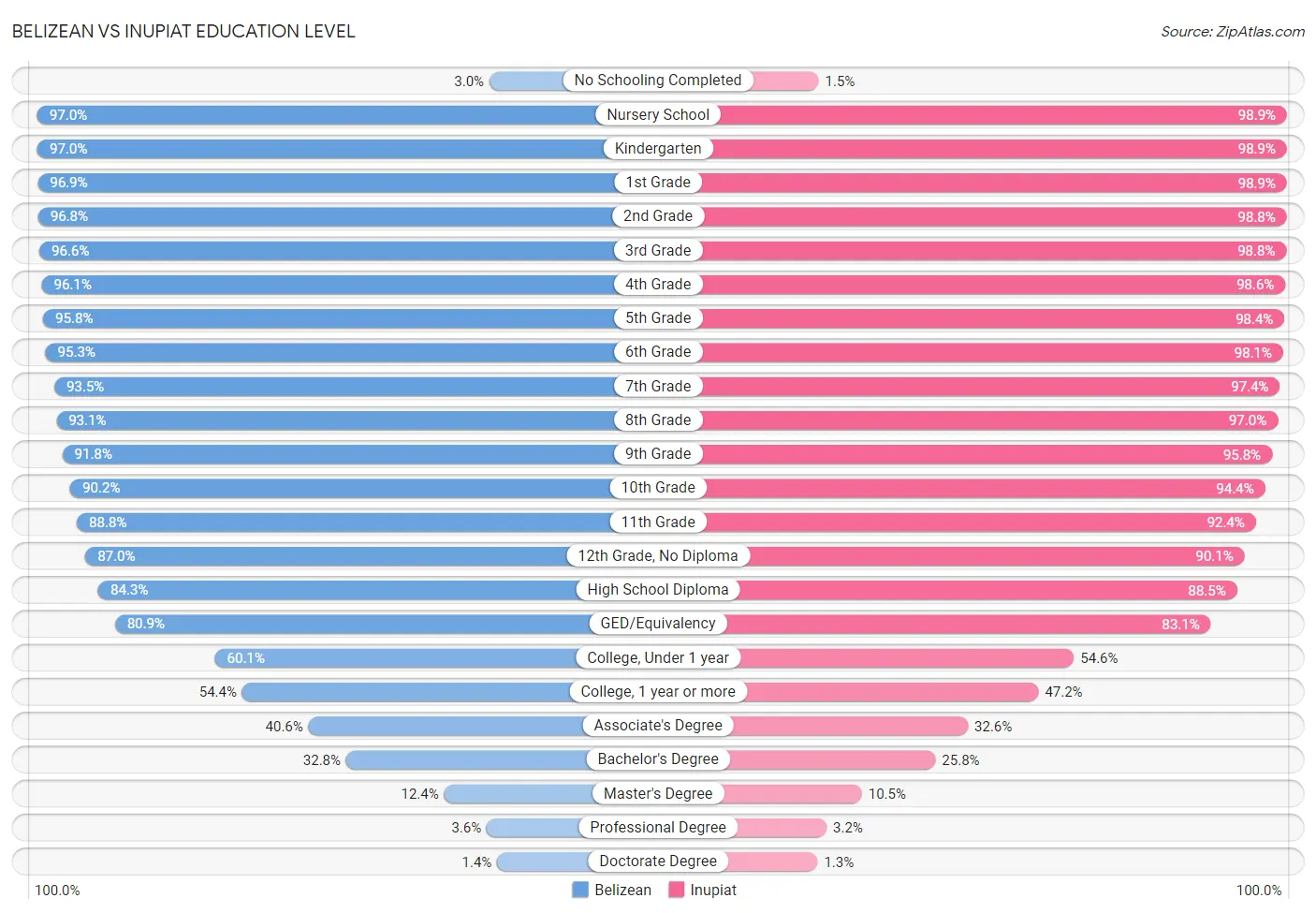
| Education Level Metric | Belizean | Inupiat |
| No Schooling Completed | Tragic 3.0% | Exceptional 1.5% |
| Nursery School | Tragic 97.0% | Exceptional 98.9% |
| Kindergarten | Tragic 97.0% | Exceptional 98.9% |
| 1st Grade | Tragic 96.9% | Exceptional 98.9% |
| 2nd Grade | Tragic 96.8% | Exceptional 98.8% |
| 3rd Grade | Tragic 96.6% | Exceptional 98.8% |
| 4th Grade | Tragic 96.1% | Exceptional 98.6% |
| 5th Grade | Tragic 95.8% | Exceptional 98.4% |
| 6th Grade | Tragic 95.3% | Exceptional 98.1% |
| 7th Grade | Tragic 93.5% | Exceptional 97.4% |
| 8th Grade | Tragic 93.1% | Exceptional 97.0% |
| 9th Grade | Tragic 91.8% | Exceptional 95.8% |
| 10th Grade | Tragic 90.2% | Exceptional 94.4% |
| 11th Grade | Tragic 88.8% | Average 92.4% |
| 12th Grade, No Diploma | Tragic 87.0% | Tragic 90.1% |
| High School Diploma | Tragic 84.3% | Poor 88.5% |
| GED/Equivalency | Tragic 80.9% | Tragic 83.1% |
| College, Under 1 year | Tragic 60.1% | Tragic 54.6% |
| College, 1 year or more | Tragic 54.4% | Tragic 47.2% |
| Associate's Degree | Tragic 40.6% | Tragic 32.6% |
| Bachelor's Degree | Tragic 32.8% | Tragic 25.8% |
| Master's Degree | Tragic 12.4% | Tragic 10.5% |
| Professional Degree | Tragic 3.6% | Tragic 3.2% |
| Doctorate Degree | Tragic 1.4% | Tragic 1.3% |
Belizean vs Inupiat Disability
When considering disability, the most significant differences between Belizean and Inupiat communities in the United States are seen in disability age under 5 (1.2% compared to 3.7%, a difference of 218.9%), hearing disability (2.8% compared to 4.7%, a difference of 70.9%), and disability age 65 to 74 (25.8% compared to 34.5%, a difference of 33.7%). Conversely, both communities are more comparable in terms of disability age 18 to 34 (6.4% compared to 6.5%, a difference of 0.95%), disability (11.9% compared to 12.2%, a difference of 1.8%), and disability age 5 to 17 (5.4% compared to 5.7%, a difference of 4.4%).
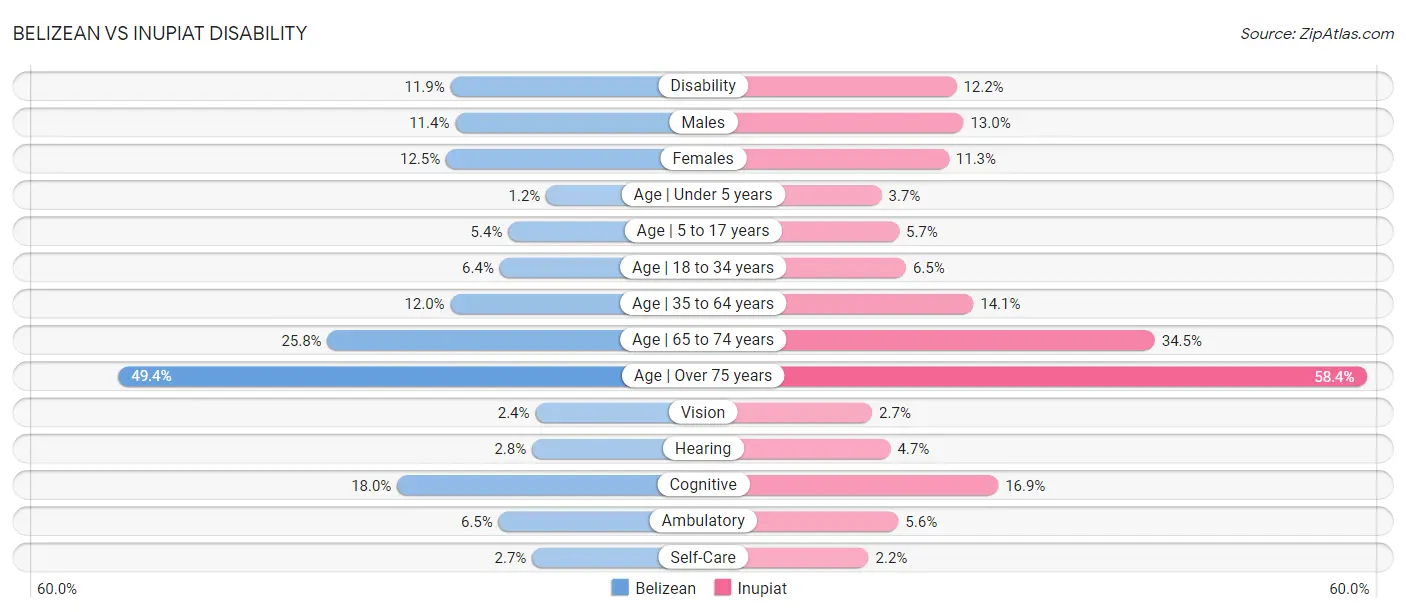
| Disability Metric | Belizean | Inupiat |
| Disability | Poor 11.9% | Tragic 12.2% |
| Males | Fair 11.4% | Tragic 13.0% |
| Females | Tragic 12.5% | Exceptional 11.3% |
| Age | Under 5 years | Exceptional 1.2% | Tragic 3.7% |
| Age | 5 to 17 years | Exceptional 5.4% | Fair 5.7% |
| Age | 18 to 34 years | Excellent 6.4% | Good 6.5% |
| Age | 35 to 64 years | Tragic 12.0% | Tragic 14.1% |
| Age | 65 to 74 years | Tragic 25.8% | Tragic 34.5% |
| Age | Over 75 years | Tragic 49.4% | Tragic 58.4% |
| Vision | Tragic 2.4% | Tragic 2.7% |
| Hearing | Exceptional 2.8% | Tragic 4.7% |
| Cognitive | Tragic 18.0% | Exceptional 16.9% |
| Ambulatory | Tragic 6.5% | Exceptional 5.6% |
| Self-Care | Tragic 2.7% | Exceptional 2.2% |